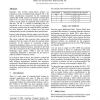Free Online Productivity Tools
i2Speak
i2Symbol
i2OCR
iTex2Img
iWeb2Print
iWeb2Shot
i2Type
iPdf2Split
iPdf2Merge
i2Bopomofo
i2Arabic
i2Style
i2Image
i2PDF
iLatex2Rtf
Sci2ools
SCS
2004
2004
Engineering Judgement
Engineers who develop safety-related systems are required to work to remarkably high standards: SIL 1, the lowest classification recognised by the international standard IEC 61508, requires a probability of failure/hour (pfh) of 10-5 or lower; and many systems are required to achieve several orders of magnitude lower failure rates than this. Yet SIL 1 is already so demanding that it is impractical to test a system for long enough to provide convincing evidence that the required failure probability has been achieved, and few systems have ever been mathematically proved to implement their specifications. Instead, safety engineers develop safety cases that argue, and seek to show, that the required pfh has been achieved. The safety authority then exercises their engineering judgement that the system will have the required safety properties. In the absence of convincing evidence, engineering judgement seems our only recourse, yet the great physicist, Richard Feynman, remarked in his book ...
| Added | 31 Oct 2010 |
| Updated | 31 Oct 2010 |
| Type | Conference |
| Year | 2004 |
| Where | SCS |
| Authors | Martyn Thomas |
Comments (0)

